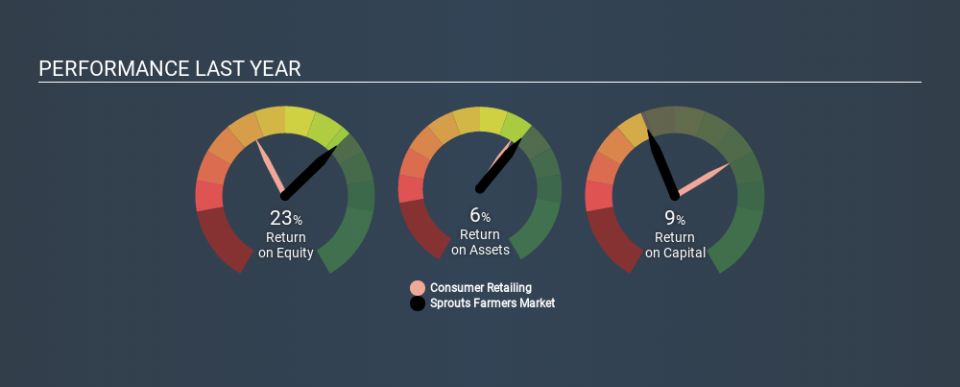Do You Know About Sprouts Farmers Market, Inc.’s (NASDAQ:SFM) ROCE?

Today we'll look at Sprouts Farmers Market, Inc. (NASDAQ:SFM) and reflect on its potential as an investment. In particular, we'll consider its Return On Capital Employed (ROCE), as that can give us insight into how profitably the company is able to employ capital in its business.
First, we'll go over how we calculate ROCE. Second, we'll look at its ROCE compared to similar companies. Finally, we'll look at how its current liabilities affect its ROCE.
Return On Capital Employed (ROCE): What is it?
ROCE is a metric for evaluating how much pre-tax income (in percentage terms) a company earns on the capital invested in its business. In general, businesses with a higher ROCE are usually better quality. Overall, it is a valuable metric that has its flaws. Author Edwin Whiting says to be careful when comparing the ROCE of different businesses, since 'No two businesses are exactly alike.
So, How Do We Calculate ROCE?
The formula for calculating the return on capital employed is:
Return on Capital Employed = Earnings Before Interest and Tax (EBIT) ÷ (Total Assets - Current Liabilities)
Or for Sprouts Farmers Market:
0.093 = US$214m ÷ (US$2.8b - US$472m) (Based on the trailing twelve months to September 2019.)
Therefore, Sprouts Farmers Market has an ROCE of 9.3%.
See our latest analysis for Sprouts Farmers Market
Does Sprouts Farmers Market Have A Good ROCE?
One way to assess ROCE is to compare similar companies. It appears that Sprouts Farmers Market's ROCE is fairly close to the Consumer Retailing industry average of 9.0%. Aside from the industry comparison, Sprouts Farmers Market's ROCE is mediocre in absolute terms, considering the risk of investing in stocks versus the safety of a bank account. It is possible that there are more rewarding investments out there.
We can see that, Sprouts Farmers Market currently has an ROCE of 9.3%, less than the 19% it reported 3 years ago. Therefore we wonder if the company is facing new headwinds. The image below shows how Sprouts Farmers Market's ROCE compares to its industry, and you can click it to see more detail on its past growth.
It is important to remember that ROCE shows past performance, and is not necessarily predictive. Companies in cyclical industries can be difficult to understand using ROCE, as returns typically look high during boom times, and low during busts. ROCE is only a point-in-time measure. What happens in the future is pretty important for investors, so we have prepared a free report on analyst forecasts for Sprouts Farmers Market.
Do Sprouts Farmers Market's Current Liabilities Skew Its ROCE?
Current liabilities include invoices, such as supplier payments, short-term debt, or a tax bill, that need to be paid within 12 months. The ROCE equation subtracts current liabilities from capital employed, so a company with a lot of current liabilities appears to have less capital employed, and a higher ROCE than otherwise. To check the impact of this, we calculate if a company has high current liabilities relative to its total assets.
Sprouts Farmers Market has total liabilities of US$472m and total assets of US$2.8b. Therefore its current liabilities are equivalent to approximately 17% of its total assets. This very reasonable level of current liabilities would not boost the ROCE by much.
The Bottom Line On Sprouts Farmers Market's ROCE
That said, Sprouts Farmers Market's ROCE is mediocre, there may be more attractive investments around. Of course, you might also be able to find a better stock than Sprouts Farmers Market. So you may wish to see this free collection of other companies that have grown earnings strongly.
If you like to buy stocks alongside management, then you might just love this free list of companies. (Hint: insiders have been buying them).
If you spot an error that warrants correction, please contact the editor at editorial-team@simplywallst.com. This article by Simply Wall St is general in nature. It does not constitute a recommendation to buy or sell any stock, and does not take account of your objectives, or your financial situation. Simply Wall St has no position in the stocks mentioned.
We aim to bring you long-term focused research analysis driven by fundamental data. Note that our analysis may not factor in the latest price-sensitive company announcements or qualitative material. Thank you for reading.

